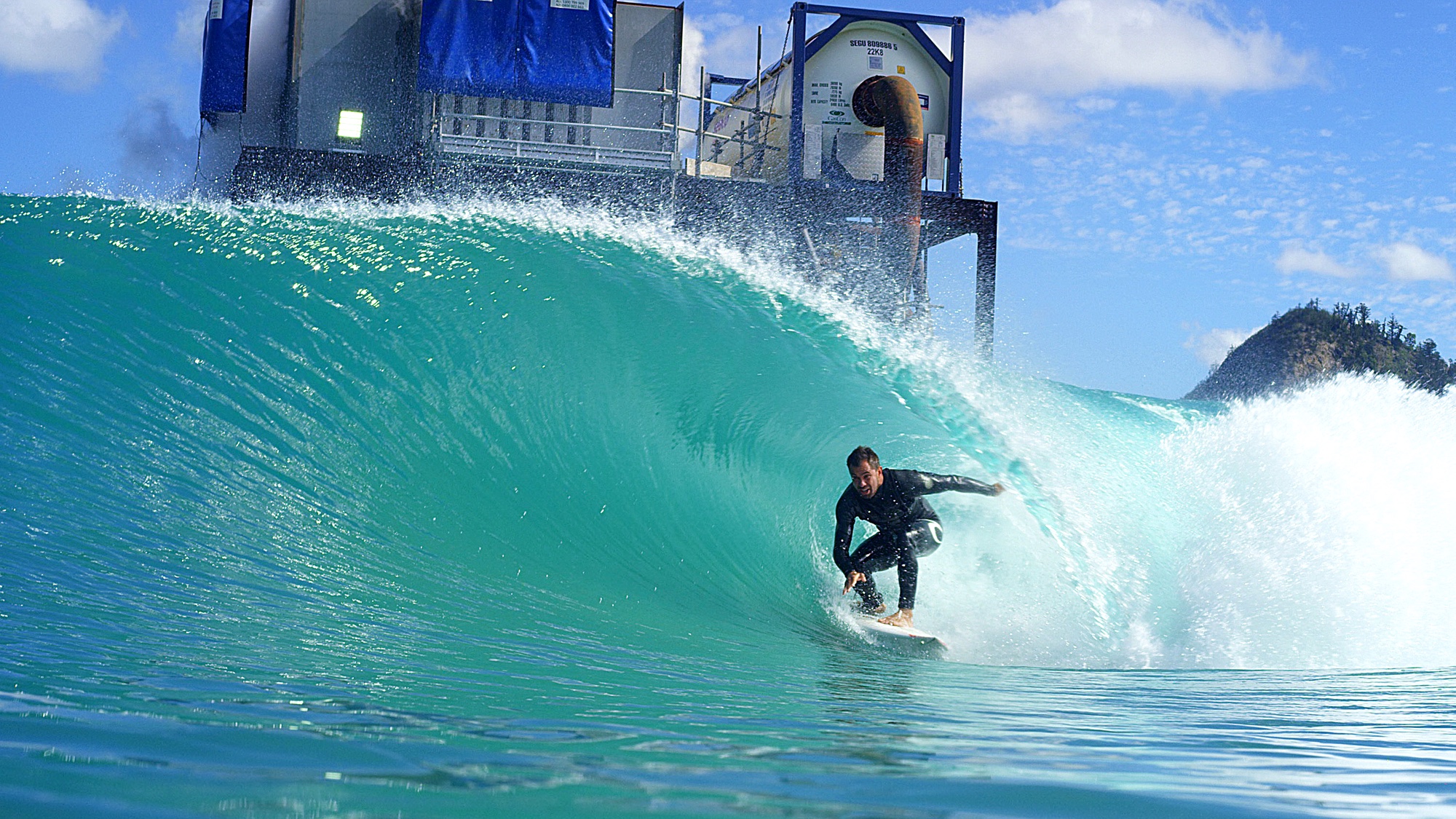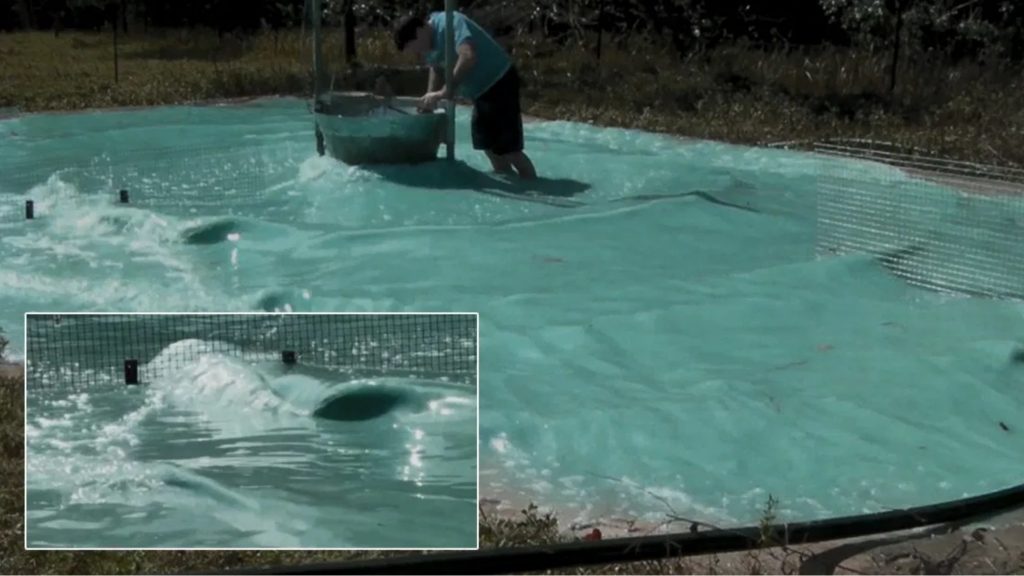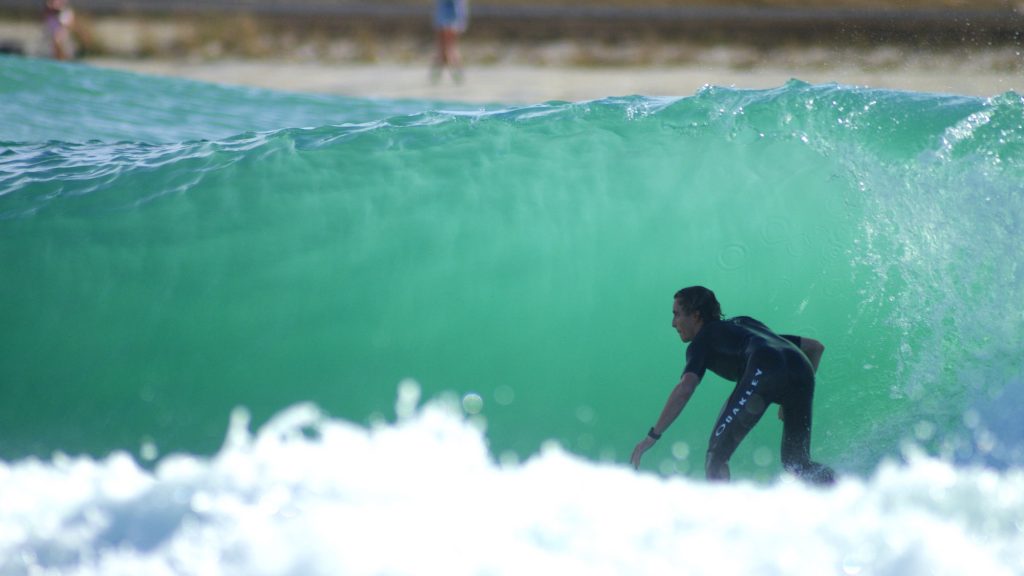Quick catchup: 5 years of Surf Lakes

Aaron Trevis has been tinkering away for well more than five years on Surf Lakes. He built small 1:25 and 1:10 prototypes of the plunger to see if the idea could work. It did. Despite this major triumph, the small machine sat in Aaron’s backyard in Brisbane.
Then in July 2016 with the help of Engenuity Solutions (Dr. Chris Hawley, Kit Sidwell) plans were scratched out to go big in Yeppoon.
“We refined the bathymetry and tuning of the machine, whilst designing and patenting the drive mechanism, ready for the full-scale prototype in Yeppoon,” said Trevis. “The wave pool industry was starting to grow, and the need to show surfers on waves was apparent.”
The R&D facility was constructed, and the first waves were created in October 2018.

The Yeppoon R&D facility has become a media darling while behind the scenes there have been many refinements, fixes, improvements and tweaks.
“Since then the Yeppoon R&D facility has been refined in front of a growing chorus of support and like any start-up there have many highs and equal lows,” said Trevis. “But we are now proudly moving forward rapidly!”
Licensing has been fast in 2021, with Surf Lakes selling territories in Hawaii, China, the US, and elsewhere. In all, the company says they have 19 projects in the works with more to be confirmed. At time of this article, a project proposal in Israel is nearing finalization.
The upgrade to the Yeppoon R&D facility is in planning application now and will possibly be the first commercial site,” said Trevis. “But there are sites in USA closing in fast with a view to turn soil this year.”
Excerpts from an interview late last year with Aaron Trevis and Wayne Dart on WavePoolMag.
Surf Lakes is huge. Could you share with us what it was that made you want to go so big when you designed it?
Aaron: There were a couple of things to that strategy. One, we didn’t think it would cost as much as it did. So I was naive. Also, we weren’t the first technology. We knew that there were wave pools already out in the market. So we needed to make a statement on the wave size and, you know, just the genuine possibilities of what can be done with a decent size surf park like all the amenities and lifestyle additions that can be wrapped around it. So, yeah, we had to go out and do something a little different. That’s the way we viewed it strategically. And what we also realized for the long term is that having built it at the full size, it then reduces the risk for the licensee. So if we want to build a compact model, which we are doing now, it’s much easier to scale back. And so whilst it’s been expensive and painful for us in the long term, we believe it was the right decision.
So Yeppoon was the first shot?
Wayne: There were smaller-scale prototypes that gave the team the confidence to construct the full-sized one. And if you look at the timeline from concept to potential commercial reality, we’ve tried to compress everything down to five years, whereas the other wave pool makers have had 10 to 15 years to do that. The confidence gained by having those smaller models allowed us to actually build this big one and move forward. What we’re creating is just game-changing. And when you see it first hand, the video doesn’t do it justice, you cannot describe how awesome the whole thing is. But it wouldn’t have been possible unless we’d obviously done the smaller models.
And now you’re scaling back down a bit?
Aaron: So we’ve got the full XL Model and then the Standard model, which we will be releasing very soon. It’s a scaled-down version, so you don’t get quite the same choice in wave levels. It’s more about the intermediate and lower market with advanced waves. And so whilst you don’t create such an incredible surf destination as the XL Model, there’s a lot of locations where, you know, it’s learning to swim before you learn to surf. And then it is really just about family fun and entertainment. They’re not necessarily looking at it as a surf destination as such, but it can still be an incredible surf experience. So they’re really the two extremes if you like. And I think there are even shopping centers that want to create a mini version from that again, which we can explore as well. But the main thrust is the XL model and then the Standard model, which will be more compact for about two-thirds of the price.

So how does it work with licensees? If I approach you with sufficient funds can I be the surf licensee for, say, France?
Aaron: Typically, it’s a smaller area, it might be a city or a state rather than the whole country, but there are small countries in Europe that it makes sense to license out the whole country. So it’s not really by geographic region, it’s by project. We wouldn’t just license all of California, you know, there can be multiple projects throughout that state and the same goes for Texas and Florida and other countries like Australia. You wouldn’t just have one license for a big country like Australia. Well, you would if you were prepared to pay enough. And I guess that’s the thing is it depends really on the passion and level of expectation of the licensee as to what they want to have exclusively. So we’re prepared to consider bigger areas for people who are prepared to pay for that and demonstrate that they can deliver multiple projects. It’s really analysis. It’s getting to know those people because we actually will be tied in with the project for 25 years and monitoring and auditing that project. So we have a request for proposal process that Wayne has put together with the team to allow us to conduct due diligence on the licensees whilst they conduct due diligence on us. And so once we’re all happy that we’ve got an aligned value set. Some people have very capable developers but don’t really want to operate the surf park. They just love the amenity and they want to develop 2000 apartments or whatever it is around the wave pool and have someone else operate it. That’s still valid in our mind because we can find operators or even develop our operations capacity for that. Then others just want to have a wonderful surf resort that they operate themselves.
What are some of the scenarios that could work with your wave pool system?
Wayne: So you might have one experience that’s open 24/7 to the public and it’s mums and kids. And it’s a rush-rush type scenario, something similar to a public swimming pool. But you also might have at the other end a camping-type scenario where it’s people going on a surf trip and just, you know, enjoying a casual country experience. You can also have an exclusive experience, which would sit in the middle of a high-end residential or gated community, which is only open to those people that are living in that particular space. So there’s several different experiences that we can offer and that comes back down to the sheer size of the full-scale 5 Waves model. Having such an obviously fantastic perimeter to work with, which certainly separates us from the square-on-all-sides wave pools.
Related Coverage
